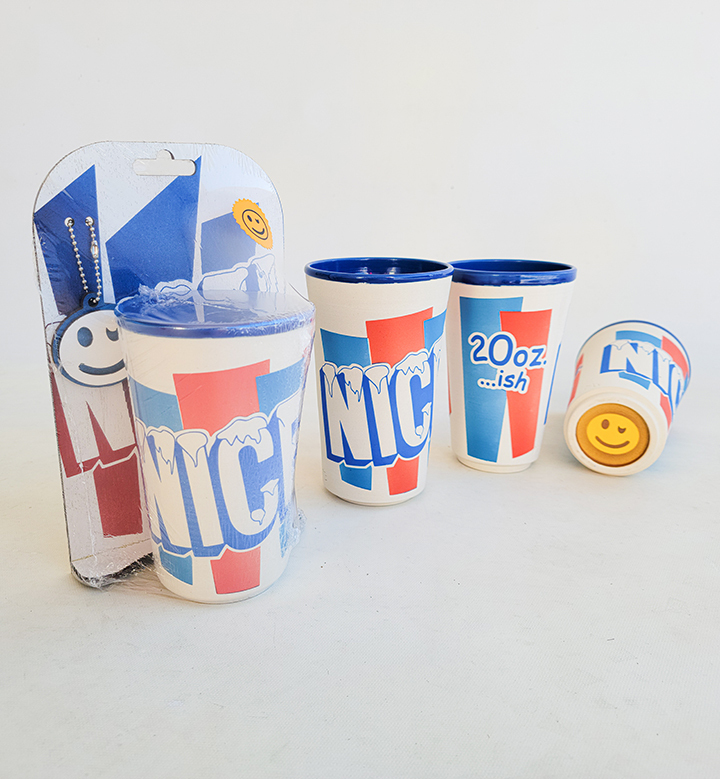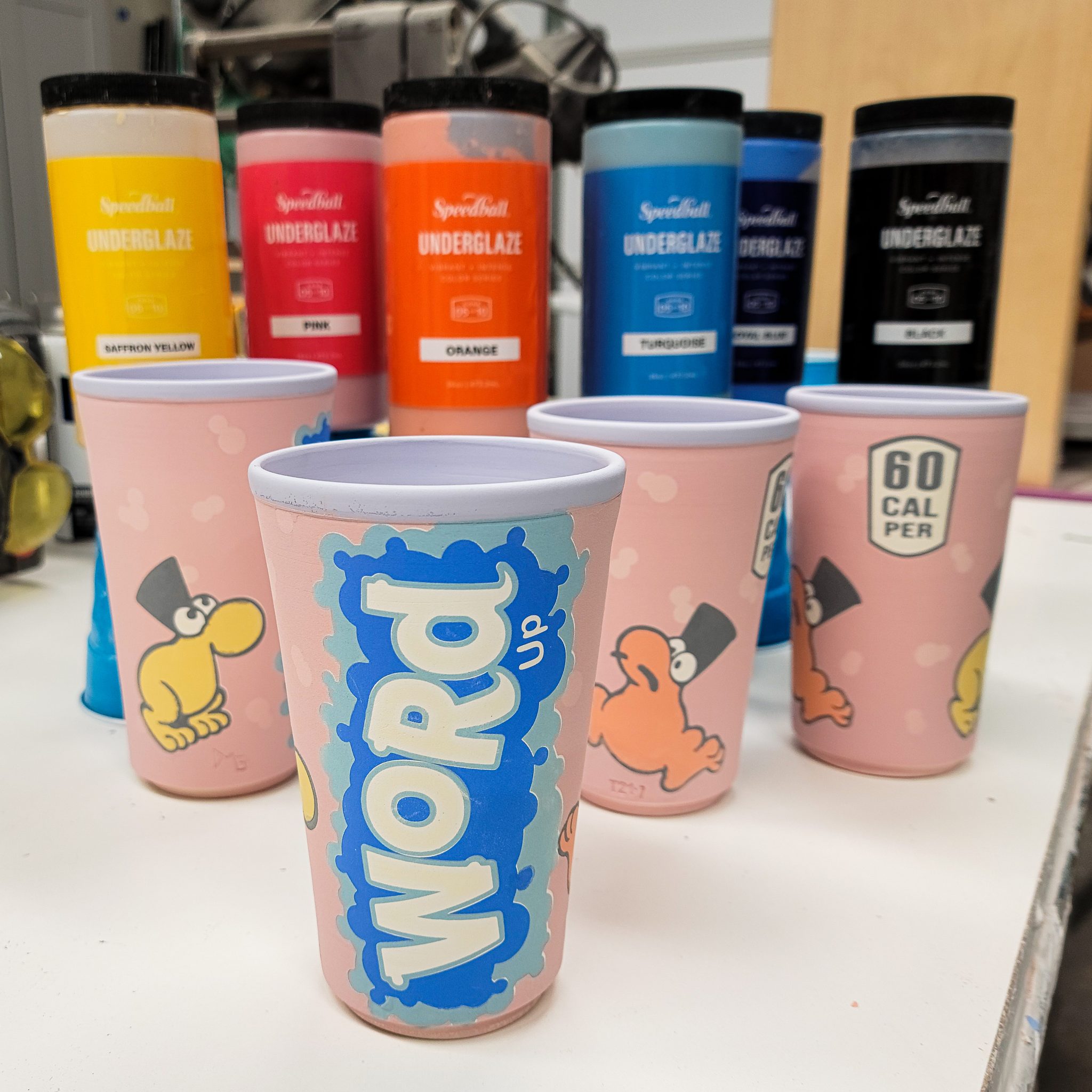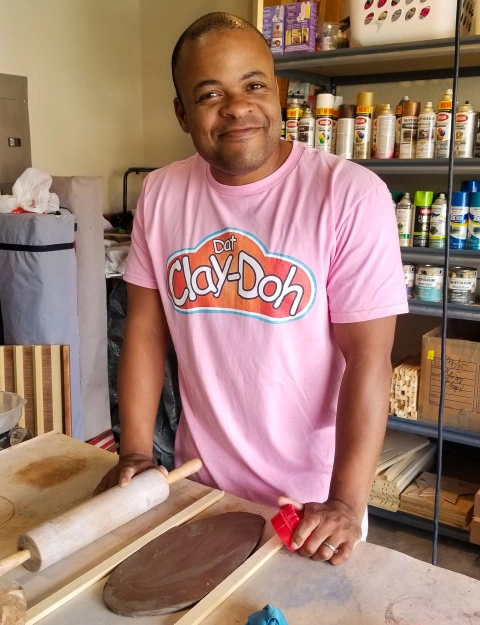Manifesting Beauty From Artistic Challenges With Potter Delvin Goode
February 23, 2022Punchy colours and familiar eye-catching designs captivate our minds as we appreciate Delvin Goode’s artwork. The US Air Force member and artist uncovered his love for ceramics in an elective during his undergrad studies. Since then Delvin has put in many hours honing those skills, experimenting with different tools, and bringing smiles to people’s faces! We sat down with Delvin to learn more about his practice and are sharing the must-know with you!

Many of your designs stem from Americana – automotive logos, racetrack signage, and iconic brands. Where do you think your affinity for the style comes from?
When I was really young I used to do a lot of drawing exercises where I would redraw vintage logos without tracing. I think that is where the fascination started because I gained an appreciation for the marketing art of those times. During my undergraduate studies I chose Graphic Design as my major and the main method of instruction was figuring out how to duplicate advertisements from movie posters, to magazine covers, to brand logos. I thoroughly enjoy studying the methods that graphic artists used prior to the technological advantages that we have today. I feel the art they made was timeless as evident by the resurgence of those styles in today’s marketing. Mix that with my quirky sense of humor and I have countless inspiration to draw from for my work.
You sometimes mention you were drawn to pottery because of the challenge it posed to you, that you didn’t have instant success with it. Do you feel this challenge-seeking mindset was taught to you or something you inherently had? – If taught, is there a way we can practice this for ourselves, or help others enter this state?
I believe my challenge-seeking mindset was taught to me. As kids my father used to give my brother and I a comic book, a large poster board, and a pen. Then he would have us duplicate the cover onto the poster board using only that pen. If we messed up he challenged us to change the illustration in a way that incorporated that mistake seamlessly into our larger version. I applied this mentality to any artform I’ve ever tried and pushed myself to achieve a high level of talent per that discipline. I often didn’t have the budget to buy the “good” materials that artists used to create beautiful works as per that medium, so I focused on using what I could afford to achieve similar results. I may not be able to paint like Bob Ross but it’s going to look awfully close with these low grade acrylics I’m using, haha. Pottery was the first artform I ever tried that I couldn’t conquer with natural talent and a little determination. I realized quickly that it was going to take a lot of time and even more determination to achieve an ounce of talent. Ceramics challenges me in ways like no other artform and I love it! I think if someone wanted to adopt the same mindset in their studio, they should take an appreciative inventory of what they have available to them. It isn’t the materials in your hand, but the art in your heart. It may happen slower or not look exactly like the original plan, but with a little bit of determination you will surprise yourself with the beauty that manifests from those small artistic challenges. This is how I discovered my style and it will assuredly help others do the same.
February at Opus means our annual Opus Daily Practice Challenge. Do you have any specific approach to practice? Are there any aspects of practice do you think are often overlooked?
When it comes to ceramics, more than any other art form in my opinion, you have to practice as often as possible. If I could do something pottery related everyday that would be the optimum. However, like most of us out there we have a thousand other things requiring our attention constantly. One thing I usually tell people when I’m instructing them on the potter’s wheel is that the only difference between them and me at that point is time spent at the wheel. That is true for almost anything you’re wanting to achieve a level of excellence at. There are things we all can do though to rack those hours up, we just need to think outside the box sometimes to grow as artists.
One aspect of practice that I think is overlooked is thinking you have to physically be wheel throwing, painting, or drawing etc. in order to enhance your skills in your chosen medium. Thinking like this can keep you from taking advantage of great opportunities to grow. I’ll use my own ceramics journey as an example. When I applied to the MFA program at Fort Hays State University, it had been 15 years since I seriously sat at a potter’s wheel.

I would spend an hour or so practicing during the day, but in the evenings I watched countless pottery videos on social media studying other artists’ techniques. Fast forward a couple semesters into the program, I was in a job that kept me away from home and my studio the majority of the time. Since I was constantly flying I bought a sketchbook and some markers and started drawing and planning artwork while on the plane. I was able to try new ideas and grow as an artist miles away from the studio. I failed on paper without wasting time and materials in the studio. By the time I got back to the studio I was able to roll right through projects as if I’d been there the entire time. Point is there are more ways to practice outside of spinning clay between your fingers. Be creative with the time you have and take advantage of the hidden opportunities to get better, they are out there!
What is an essential tool you learned about later on in your practice?
One of the tools I simply cannot live without in my practice is, you’re not going to believe this, but a milk frother! Oddly enough I don’t drink coffee, but this little hand held $20 device has revolutionized the way I glaze my work forever. I recently started experimenting with an airbrush to glaze my work and I was having a hard time diluting underglazes enough to go through the gun. It took a lot of time for me to stir the glaze, filter it and pour it in the airbrush. I also noticed there were chunks of glaze left over on the screen that was useful if only I could get it to break down. I remembered my wife recently bought a frother but she hadn’t used it yet. I brought it in the studio and started using it to mix the underglaze with the water and eureka! Instant blending, no more filtering, and the glaze flowed smoothly through the airbrush. I started using the frother to prep all other glaze types prior to applying them and I’ve never turned back.

How do you go about choosing a clay to work with?
Honestly the main way I choose which clay I’m going to work is based on what clay is available to me at the time. In my day to day job I move quite a bit, so every state and city we move to has different local options. I love the versatility that white clay provides when it comes to colour application, so I usually look for an easy to throw low-fire and mid-range white clay. I fire my own work at home so I don’t fire hotter than cone 6, which limits the clays I choose from as well. Clean up with lighter clays is also much easier and quicker, which is also a factor. I do use the darker clays at times but it is limited in my normal practice. After those considerations it boils down to the success rate of me working with it and analyzing the final results from form to finish.
What colours or palettes are you drawn to? Do you have a favourite colour in the Speedball Underglaze line up?
I am most drawn to the primary colors as my favourite palette, but I’ve never been known to turn a good colour or combination down. Colour to me is probably the most important factor in all of my works. In fact that is the absolute reason I switched to using Speedball glazes in my surface decoration. I got frustrated with unpredictable colors coming out of my kiln with other brands. So I gave Speedball a try and finally felt at peace with the glazes on my work. My go-to most favourite color has to be the Saffron Yellow from the Speedball Underglaze line up! Royal Blue is definitely a close second.
What are the essential tools you recommend to get started in ceramics?
The essential tools I would recommend for anyone starting in ceramics is that basic tool kit you find usually wrapped in plastic and has a sponge,wooden rib, metal rib, needle tool etc. I still use those basic tools wherever I’m in the studio and every other refined pottery tool can be traced back to items in that basic kit.

As you get more refined in your practice, definitely branch out, but that kit is awesome in my opinion. Another essential tool is a scale because you’ll quickly find that you’ll want to track how much clay you’re using each time. Last on my essential list is a milk frother. Trust me you won’t regret it!
If you could give some words of wisdom to yourself or your peers when just starting ceramics, what would you say?
The only difference between you and those that you look up to in ceramics is time spent doing it. It is as simple as that. No two people do the ceramics the same, it is impossible to do so. Imitation is a wonderful form of flattery, but in ceramics it’s a limitation. What you need to do is spend time creating while at the same time learning from what others are doing, and gain an understanding of why they are doing it that way. Take that knowledge back to your creative space and adapt what works to your particular practice. Learn to trust your evolving processes and expect to fail more often than you would like. However, learn to celebrate those failures because the time you spent in those failures still contributed to your artistic growth, and you are a better artist for it. Understand all of this and your personal style will emerge in ways you can’t imagine at this moment, and you are going to love it!
Upcoming Demonstrations With Delvin Goode

Clay Underglaze Methods with Delvin Goode

